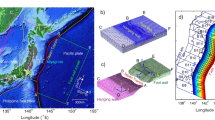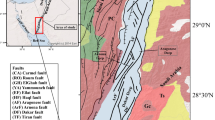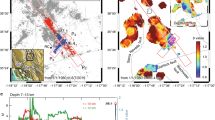Abstract
On 17 August 1999, a destructive magnitude 7.4 earthquake occurred 100 km east of Istanbul, near the city of Izmit, on the North Anatolian fault. This 1,600-km-long plate boundary1,2 slips at an average rate of 2–3 cm yr-1 (refs 3,4,5), and historically has been the site of many devastating earthquakes6,7. This century alone it has ruptured over 900 km of its length6. Models of earthquake-induced stress change8 combined with active fault maps9 had been used to forecast that the epicentral area of the 1999 Izmit event was indeed a likely location for the occurrence of a large earthquake9,10. Here we show that the 1999 event itself significantly modifies the stress distribution resulting from previous fault interactions9,10. Our new stress models take into account all events in the region with magnitudes greater than 6 having occurred since 1700 (ref. 7) as well as secular interseismic stress change, constrained by GPS data11. These models provide a consistent picture of the long term spatio–temporal behaviour of the North Anatolian fault and indicate that two events of magnitude equal to, or greater than, the Izmit earthquake are likely to occur within the next decades beneath the Marmara Sea, south of Istanbul.
This is a preview of subscription content, access via your institution
Access options
Subscribe to this journal
Receive 51 print issues and online access
$199.00 per year
only $3.90 per issue
Buy this article
- Purchase on Springer Link
- Instant access to full article PDF
Prices may be subject to local taxes which are calculated during checkout



Similar content being viewed by others
References
Barka, A. A. 17 August 1999 Izmit earthquake. Science 258, 1858–1859 (1999).
Barka, A. A. The North Anatolian Fault zone. Ann. Tectonicae VI (suppl.), 164–195 (1992).
Reilinger, R. E. et al. Global Positioning System measurements of the present-day crustal movements in the Arabia-Africa-Eurasia plate collision zone. J. Geophys. Res. 102, 9983–9999 (1997).
Hubert, A. La Faille Nord-Anatolienne (Cinématique, Morphologie, Localisation, Vitesse et Décalage Total) et Modélisations Utilisant la Contrainte de Coulomb sur Différentes Echelles de Temps. Thesis, Denis Diderot Univ., Paris VII (1998).
Armijo, R., Meyer, B., Hubert, A. & Barka, A. Westward propagation of the North Anatolian fault into the northern Aegean: Timing and kinematics. Geology 27, 267–270 (1999).
Ambraseys, N. N. Some characteristic features of the North Anatolian fault zone. Tectonophysics 9, 143–165 (1970).
Ambraseys, N. N. & Finkel, C. Long-term seismicity of Istanbul and of the Marmara Sea region. Terra Nova 3, 527–539 (1991).
King, G. C. P., Stein, R. S. & Lin, J. Static stress changes and the triggering of earthquake. Bull. Seismol. Soc. Am. 84, 935– 953 (1994).
Nalbant, S. S., Hubert, A. & King, G. C. P. Stress coupling between earthquakes in northwest Turkey and the north Aegean Sea. J. Geophys. Res. 103 , 24469–24466 (1998).
Stein, R. S., Barka, A. A. & Dieterich, J. H. Progressive failure on the North Anatolian fault since 1939 by earthquake stress triggering. Geophys. J. Int. 128, 594–604 (1997).
Straub, C., Khale, H. G. & Schindler, C. GPS and geological estimates of the tectonic activity in the Marmara Sea region, NW Anatolia. J. Geophys. Res. 102, 27587–27601 (1997).
Barka, A. A. & Kadinsky-Cade, K. Strike-slip fault geometry in Turkey and its influence on earthquake activity. Tectonophysics 7, 663–684 ( 1988).
Harris, R. A. Stress triggers, stress shadows and implications for seismic hazard. J. Geophys. Res. 103, 24347–24358 (1998).
Harris, R. A. & Simpson, R. W. In the shadow of 1857- Effect of the great Ft. Tejon earthquake on subsequent earthquakes in southern California. Geophys. Res. Lett. 23, 229– 232 (1996).
Kanamori, H. & Anderson, D. L. Theoretical basis of some empirical relations in seismology. Bull. Seismol. Soc. Am. 65 , 1073–1095 (1975).
Wittlinger, G. et al. Tomographic evidence for localized lithospheric shear along the Altyn Tagh fault. Science 282, 74– 76 (1998).
Pollitz, F. F. & Dixon, T. H. GPS measurements across the northern Caribbean plate boundary zone; impact of postseismic relaxation following historic earthquakes. Geophys. Res. Lett. 25, 2233–2236 (1998).
Ambraseys, N. N. & Finkel, C. F. in Historical Seismograms and Earthquakes of the World (eds Lee, W. H. K., Meyers, H. & Shimazaki, K.), 173–180 (Academic, San Diego, 1988).
Dieterich, J. A constitutive law for rate of earthquake production and its application to earthquake clustering. J. Geophys. Res. 99, 2601–2618 (1994).
Sornette, A. & Sornette, D. Self organized criticality and earthquake. Europhys. Lett. 9, 197 (1989).
Bowman, D. D. et al. An observational test of the critical earthquake concept. J. Geophys. Res. 103, 24359– 24372 (1998).
Okada, Y. Internal deformation due to shear and tensile fault in a half-space. Bull. Seismol. Soc. Am. 82, 1018–1040 (1982).
Segall, P. & Harris, R. Slip deficit on the San Andreas Fault at Parkfield, California, as revealed by inversion of geodetic data. Science 233, 1409–1413 ( 1986).
Acknowledgements
We thank F. F. Pollitz and R. Harris for comments on the manuscript. This work was supported by the EEC FAUST programme and the INSU-CNRS PNRN programmes.
Author information
Authors and Affiliations
Corresponding author
Supplementary information
Rights and permissions
About this article
Cite this article
Hubert-Ferrari, A., Barka, A., Jacques, E. et al. Seismic hazard in the Marmara Sea region following the 17 August 1999 Izmit earthquake. Nature 404, 269–273 (2000). https://doi.org/10.1038/35005054
Received:
Accepted:
Issue Date:
DOI: https://doi.org/10.1038/35005054
This article is cited by
-
The Mw = 5.8 2019 Silivri earthquake, NW Türkiye: is it a warning beacon for a big one?
International Journal of Earth Sciences (2024)
-
Investigation the effects of earthquake in Golcuk-Izmit (17 Aug 1999) by using GPS
Arabian Journal of Geosciences (2023)
-
Stress change generated by the 2019 İstanbul–Silivri earthquakes along the complex structure of the North Anatolian Fault in the Marmara Sea
Earth, Planets and Space (2022)
-
Dynamic deformation and fault locking of the Xianshuihe Fault Zone, Southeastern Tibetan Plateau: implications for seismic hazards
Earth, Planets and Space (2022)
-
Tsunami potential source in the eastern Sea of Marmara (NW Turkey), along the North Anatolian Fault system
Landslides (2022)
Comments
By submitting a comment you agree to abide by our Terms and Community Guidelines. If you find something abusive or that does not comply with our terms or guidelines please flag it as inappropriate.



